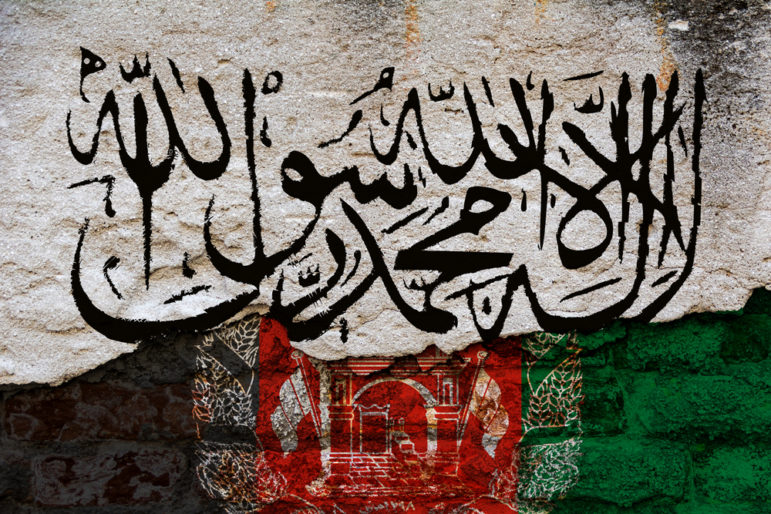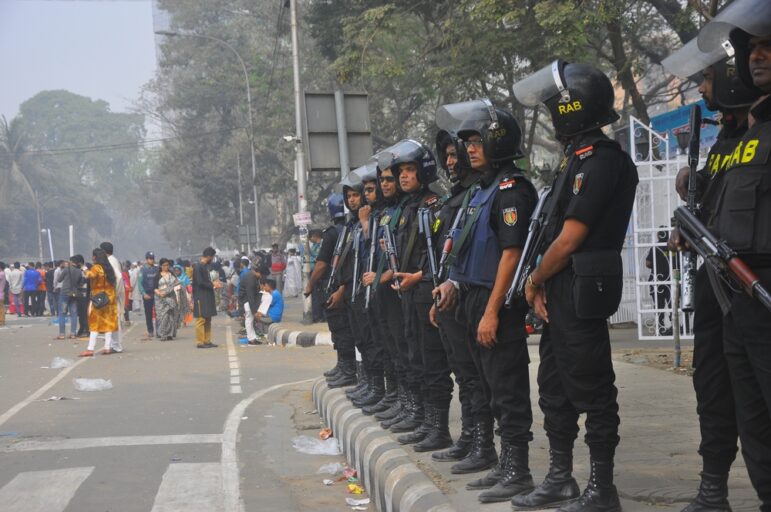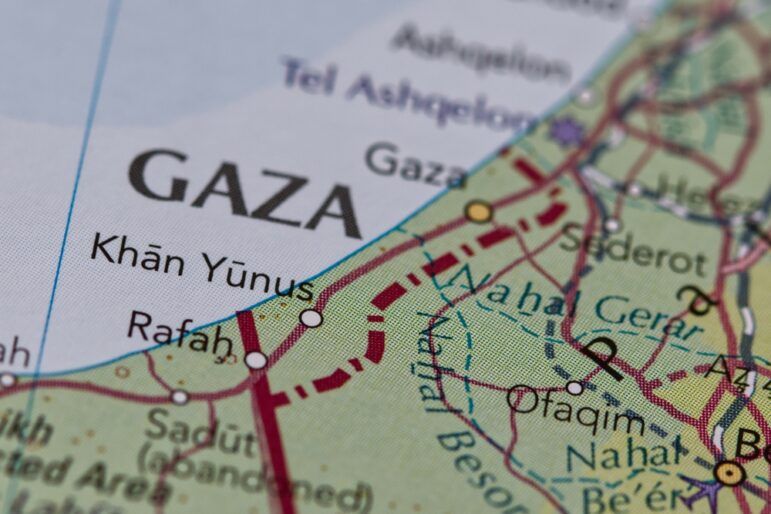

Image: Shutterstock
Afghanistan’s Watchdog Journalists Turn to Leaks and Offshore Sites
Read this article in
In the aftermath of the Taliban regime’s takeover of Afghanistan, an extraordinary adjustment has taken place within the country’s journalism community. Some newsrooms have fully relocated abroad while other reporters remain behind and instead leak critical stories about the government to their partners in exile.
Despite Taliban promises to respect human rights and freedom of the press, independent media outlets have now virtually disappeared inside Afghanistan and print editions of banished media organizations have ceased to exist, forcing many reporters to flee the country. Women journalists inside Afghanistan have been specifically targeted, and quickly pushed out of the profession en masse. In response to this crackdown, the reporters remaining in the country have resorted to passing encrypted messages with evidence of corruption, misuse of authority, and violations of human rights to exiled colleagues running Afghan news media sites hosted abroad.
“This collaboration of leaks between Afghan journalists is an antidote to keep investigative journalism alive,” says Samiullah Mahdi, a well-known Afghan journalist who recently authored “The Pen vs. the AK-47: The Future of Afghan Media Under the Taliban” for Harvard University’s Shorenstein Center. Mahdi recalls how he was forced into self-confinement in his Kabul office for two months prior to the Taliban takeover after Haqqani Network agents threatened his life. He fled to Istanbul just one day before the Taliban seized Kabul’s Presidential Palace on August 15.

Samiullah Mahdi (left) interviews former Afghan President Ashraf Ghani, Kabul, Afghanistan. Image: Courtesy of Samiullah Mahdi
Facing dire circumstances, some Afghan journalists have committed themselves to sustaining a culture of watchdog journalism — albeit on a limited scale compared to before Taliban control. As a result, the work of numerous Afghan journalists now appears anonymously in stories on news sites run from the US and other countries outside the region, to prevent retribution from the Taliban. Many exiled journalists don’t even consider it safe to host their news sites in Pakistan, as they fear intelligence-sharing between the neighboring countries may lead to their deportation back to Afghanistan.
“Media outlets such as PAYK, Etilaat Roz, Rukhshana Media, 8am (or Hasht-e-Subh Daily) and a few more, mostly operating online from outside of Afghanistan, stood up for journalistic values,” explains Mahdi, referring to some of the small news sites and nonprofits still focused on covering the country. After the Taliban takeover, Mahdi and other veteran journalists who co-founded the PAYK Investigative Journalism Center, a GIJN member, reconstituted it outside the country.
Zaki Daryabi, founder and editor of Etilaat Roz, however, is already sounding the alarm on how long this journalism pipeline to the outside world can last. Having also relocated to the US, Daryabi is left with publishing an online edition of Etilaat Roz after his national daily’s print version was shuttered. He also had to relocate the hosting of his website to the US to avoid possible censorship or a shutdown.

Afghan journalist Neamatullah Naqdi sustained injuries to his head, back, and legs during a Taliban attack while covering a women’s anti-government protest in Kabul in September. Image: Etilaat Roz
Mahdi also warns that success doesn’t come easy for news websites based outside the country. “It is very difficult to verify information,” he explains. Before the Taliban seized power, PAYK Media was regularly breaking investigative reports, but Mahdi acknowledges that the site hasn’t succeeded in pulling off any scoops since.
“Taliban men chase and hunt down journalists for anything published or aired against them or their government,” Daryabi says. For example, his younger brother, journalist Taqi Daryabi, along with fellow reporter Neamatullah Naqdi, were tortured in what they believe was retaliation for covering a women’s anti-government protest in Kabul for Etilaat Roz this past September.
The State of Independent Media
When former President Ashraf Ghani’s government collapsed in mid-August 2021, a crackdown on independent media seemed imminent, prompting a deluge of independent journalists to leave the country. One estimate by a former Afghanistan official put the number of journalists and media workers who fled at 7,000. Some boarded evacuation flights to the US; others traveled via Dubai to the UK, Australia, Germany, France, and the Czech Republic. Many crossed the border into Pakistan using tourist visas, and then departed for Qatar, Libya, Lebanon, Albania, and elsewhere.
Still, a large number of journalists remain in Afghanistan. It didn’t take long for them to link back up with their colleagues overseas — and soon after, a pipeline of leaks developed.
However, local reporters must be extra cautious when sending information and documents to their colleagues abroad. To dodge the Taliban’s virtual tracking, they avoid using personal mobile phones, SIM cards, or traceable IP (Internet Protocol) addresses to send their reports on the new regime. Instead, Afghan journalists must employ security tradecraft, such as utilizing local internet cafes incognito, or transmitting via spare mobile phones or laptops while traveling, to avoid identification by authorities.
“It is never easy,” a Kabul-based reporter who requested anonymity says of the process. “The access to information and sources entails grave danger. Whereas it is central to credible investigative journalism, our personal safety and those of our families’ remains on our minds, too.” Daryabi concurs, saying that many local journalists refuse to work with him due to risks involved.
Despite the best efforts of both ends of this reporting channel, there are limits to what it can produce. “The government officials and those from private organizations linked to a story do not respond to our queries,” Daryabi explains in frustration. “We have lost many stories. Local reporters have lost contact with their sources. They do not have the capacity and means to do it. They are like unarmed soldiers.”
A Press Landscape in Ruins
The impact of the Taliban on Afghanistan’s independent media has been devastating.
According to a recent report from the Afghan National Journalists Union (ANJU), more than 300 media outlets including print, radio, and TV stations have closed operations due to financial hardships and state censorship, and more than half of media workers have lost their jobs. A media survey by Reporters Without Borders (RSF) and the Afghan Independent Journalists Association (AIJA) found similarly catastrophic numbers. It also found that women journalists in Afghanistan have been hit even harder, as roughly four out of five are now out of work.
As a result of widespread harassment, many online media groups have been forced to move their website hosting outside Afghanistan. What’s more, loyal readers in the country must now turn to proxy servers or Virtual Private Networks (VPNs) to access banned news websites that dare to challenge the Taliban narrative. Links to uncensored news articles and exposés are secretly shared in WhatsApp groups or social media sites through unknown profiles for wider dissemination.
In addition, main TV broadcasting channels like Tolo News and Ariana News have had to reduce their broadcast airtime from 24 hours down to 10-12 hours a day due to financial constraints. Likewise, the number of news bulletins have been cut in half. News talk shows have all but disappeared, as guests dare not confront or question Taliban representatives, lest they put their lives at risk.
“Dozens of journalists have since been brutally beaten up by Taliban foot soldiers,” commented a Kabul-based journalist on the condition of anonymity. None of the attackers has been held accountable.
Afghanistan has also become the deadliest place in the world for journalists. A recent International Federation of Journalists report found that nine reporters were killed in the country due to work-related violence in 2021, the highest total across the globe. And during the first 100 days of Taliban rule, according to NAI, at least six journalists lost their lives under varying circumstances.
Under these dire conditions, Mahdi says media organizations and journalists still on the ground in Afghanistan today face only one choice: fall in line. As a survival tactic, the business-oriented media has become the Taliban’s mouthpiece, only running official statements, events, and whatever is approved by the regime. Everything else is self-censored.
This leaves the local media to cover innocuous daily life stories or issues related to humanitarian assistance programs — which can give the Taliban leverage to negotiate with the international community. Journalists are strictly barred from reporting on corruption or misuse of authority under Taliban rule, as well as human rights abuses, violations of women’s rights, closure of educational institutions, persecution of minorities, extra-judicial killings, economic or judicial policies, mismanagement or governance incompetence, rampant unemployment, or the clampdown on journalists and the media. The only investigative reporting allowed is focused on exposing corruption and wrongdoing of the previous, US-backed government of President Ghani.
Anees Ur Rehman, an Afghan journalist based in Kabul, said that news reporting has crumbled under the Taliban. “As many as five bomb blasts rocked Kabul, Nangarhar, and one other province, but media couldn’t broadcast,” he explains, adding that government forces stormed into the offices of Ariana News to warn the staff of severe consequences if they reported on the attacks.
“Investigative journalism is a relic of the past” inside the nation’s borders, concludes Rehman, who is working with international media as a freelancer after quitting his job with local media outlets. “If journalists report bomb blasts or post critical news against the Taliban government on Twitter, Facebook, or Instagram, Taliban men issue online threats,” says Rehman.
The Taliban also exploit their role as the main revenue source for much of the country’s press to keep it in line, he adds. “On one hand, the state has stopped public sector advertisements to the media, and scared away advertisers in the private sector on the other,” he says.
The Taliban’s corrosive impact on the press has led to journalists feeling unable to independently check their stories. “When a female volleyball player was recently beheaded, nobody dared to verify it with the victim’s parents or families,” says Zahra Nader, editor of Rukhshana Media, a news site that recently received British journalism’s Marie Colvin Award for its work highlighting women’s issues in Afghanistan. “Women journalists are few and far between” after the Taliban takeover, Nader notes. “[Female] TV news presenters are told to wear hijab.”
Keeping the Spirit of Investigative Journalism Alive

Zaki Daryabi in the Kabul offices of Etilaat Roz, before the Taliban takeover. Image: Courtesy of Zaki Daryabi
Despite the odds against Afghan journalists, a few brave reporters continue to perform watchdog journalism at great personal risk.
For example, Etilaat Roz carried a story on the Taliban’s widespread rights violations and suspension of the Constitution after it took over Kabul. As the report detailed, the new regime repeatedly ignored its citizens’ privacy by conducting household raids and random cellphone searches under the pretext of security concerns. Soon after the damning report was published, the Ministry of Propagation of Virtue and Prevention of Vice made a point of publicly announcing a ban on the invasion of privacy and mobile phone surveillance.
In another exclusive report, the news site exposed the collapse of healthcare in the country, which has turned into a humanitarian disaster, especially for women and children. In this story, an on-the-ground reporter conducted interviews and research, found official data, and then passed it outside the country for publication. It exposed how the Taliban regime’s policies have forced doctors to leave their jobs, segregated male and female doctors, restricted women from accessing healthcare and traveling without mahram — being escorted by an immediate male family member — and prevented pregnant women from receiving specialized obstetric treatment from male doctors. All while a whopping 3.2 million children suffer from malnutrition and rampant poverty, and unemployment has prevented large numbers of people from accessing private healthcare.
And in an exposé examining the deadly suicide bombing outside the Kabul airport during the chaotic withdrawal of US forces, the nonprofit ProPublica partnered with the new reporting site Alive in Afghanistan to tell the story. The resulting investigation combined details from US military sources and Kabul-based medical staff to challenge the Pentagon’s official story that allied forces fired but never hit any Afghan civilians in the moments after the attack.
By maintaining trust with both official and unofficial sources, using various encryption tools to ensure safety, and personally meeting with experts and victims of abuse or violence, these intrepid reporters are keeping lit the torch of accountability inside the country.
Though the situation remains dire, this improvised form of watchdog journalism has jolted the Taliban regime. And it offers a ray of hope for the people of Afghanistan as well as a beleaguered press corps looking to hold power to account in one of the world’s most dangerous countries for journalists.
Additional Resources
Making Sense of Afghanistan: The Failures of Coverage, and What Comes Next
Investigative Journalism in Iraq Was Never Easy. Now It’s Almost Impossible
Why Journalists in Autocracies Should Report as If They’re in a Democracy
Amer Malik is a freelance journalist with more than 15 years of investigative reporting experience. He has worked for The News International and Arab News in Pakistan. He has also been a fellow at the East-West Center. He is based in Pakistan.











